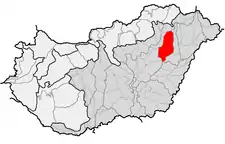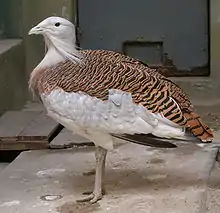Hortobágy National Park
Hortobágy (Hungarian pronunciation: [ˈhortobaːɟ]) is an 800 km2 national park in eastern Hungary, rich with folklore and cultural history. The park, a part of the Alföld (Great Plain), was designated as a national park in 1973 (the first in Hungary), and elected among the World Heritage sites in 1999.[2] The Hortobágy is Hungary's largest protected area, and the largest semi-natural grassland in Europe.[3]
| UNESCO World Heritage Site | |
|---|---|
 | |
| Location | Counties of Borsod-Abaúj-Zemplén, Heves, Hajdú-Bihar and Jász-Nagykun-Szolnok, Hungary |
| Criteria | Cultural: iv, v |
| Reference | 474 |
| Inscription | 1999 (23rd session) |
| Area | 74,820 ha |
| Buffer zone | 199,380 ha |
| Website | http://www.hnp.hu/en |
| Coordinates | 47°35′40″N 21°9′24″E |
| Official name | Hortobágy |
| Designated | 11 April 1979 |
| Reference no. | 189[1] |
 Location in Hungary | |

Until recently it was believed that this alkaline steppe was formed by the clear cutting of huge forests in the Middle Ages, followed by measures to control the course of the Tisza River, allegedly resulting in the soil's current structure and pH. However, Hortobágy is much older, with alkalinization estimated to have started ten thousand years ago, when the Tisza first found its way through the Great Hungarian Plain, cutting off many streams from their sources in the Northern Mountains. The formation was finished by grazing animals and wild horses during the Ice Age, followed by domesticated animals.[4]
One of its most iconic sites is the Nine-holed Bridge. Traditional T-shaped sweep wells dot the landscape, as well as the occasional mirage of trees shimmering in the reflected heat of the Puszta. Part of the national park is a dark sky preserve.[5]
Hortobágy has also had more negative connotations, as a site of forced labour under the communist regime.
Flora and fauna
Hortobágy is a steppe, a grassy plain with Hungarian Grey cattle, racka, water buffalo, and horses tended by herdsmen. It provides habitat for various species including 342 species of birds. The red-footed falcon, stone curlew, great bustard and European roller are represented by breeding populations. The area is an important stopover site for migrating common cranes, dotterels, and lesser white-fronted geese.[6]
Hortobágy is also a centre for the breeding of Taurus cattle, one of several ongoing attempts to breed back the aurochs.[7][8]
Picture gallery
See also
Notes
- "Hortobágy". Ramsar Sites Information Service. Retrieved 25 April 2018.
- "Hortobágy National Park - the Puszta". UNESCO World Heritage Centre. UNESCO. Retrieved 2010-06-21.
- "A Világörökség Bizottság 26. Ülése". Archived from the original on 2007-12-09. Retrieved 2007-12-08.
- "Hortobágy National Park, The Hungarian Puszta". Nomination file for inscription of the Hortobágy National Park to the World Heritage List. Ministry for Environment and Regional Policy, Republic of Hungary. 1999. pp. 4–5. Archived from the original (PDF) on 2012-10-26. Retrieved 2010-06-21.
- "Hortobágy National Park (Hungary)". darksky.org. Retrieved 2016-10-18.
- Lengyel S, Tar J, Rózsa L (2012). "Flock size measures of migrating Lesser White-fronted Geese Anser erythropus" (pdf). Acta Zoologica Academiae Scientiarum Hungaricae. 58: 297–303.
- Margret Bunzel-Drüke: ″Projekt Taurus – En økologisk erstatning for uroksen.″ Archived 2011-10-17 at the Wayback Machine Translated into Danish by Karsten Thomsen. Lohne: ABU 2004; Århus: Nepenthes, 2005. Retrieved 26 November 2013. (in Danish)
- Waltraut Zimmermann, Lydia Kolter, Istvan Sandor: Naturschutzprojekt Hortobágy – Jahresbericht 2003. Archived 2013-12-03 at the Wayback Machine Zeitschrift des Kölner Zoo 2004. Retrieved 26 November 2013. (in German)
References
- Gorman, Gerard (1996): The Birds of Hungary. Helm (A&C Black) London, UK. ISBN 0-7136-4235-1.
External links
| Wikimedia Commons has media related to Hortobágy National Park. |


.jpg.webp)








